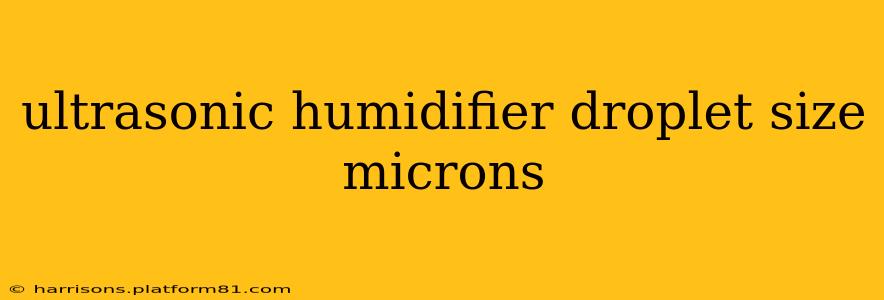Ultrasonic Humidifier Droplet Size: Microns and Their Impact
Ultrasonic humidifiers are popular for their quiet operation and ability to add moisture to the air, but the size of the water droplets they produce is a crucial factor affecting their performance and potential health implications. Understanding the micron size of these droplets is key to choosing the right humidifier and using it safely. This article delves into the specifics of ultrasonic humidifier droplet size, exploring its variations, impact on health, and factors influencing it.
What is the typical droplet size of an ultrasonic humidifier in microns?
The droplet size produced by ultrasonic humidifiers typically ranges from 1 to 10 microns. However, this is a broad range, and the exact size depends on several factors, including the humidifier's design, the water's mineral content, and even the humidity level in the room. Some models might produce a higher proportion of smaller droplets, while others may produce a wider distribution, including larger droplets. It's important to note that manufacturers rarely specify the precise droplet size distribution in their product specifications.
Are smaller droplets better in an ultrasonic humidifier?
Smaller droplets, generally under 5 microns, are considered more effective for humidification because they evaporate more quickly. This allows for faster and more efficient moisture distribution throughout a room. However, excessively small droplets can pose some potential drawbacks.
Can ultrasonic humidifier droplets be harmful?
While generally safe, some concerns exist regarding smaller droplets. The main concern revolves around the potential for inhaling these droplets, particularly if they contain minerals or impurities from the water. Inhaling very small droplets can potentially irritate the lungs in susceptible individuals, although this is usually not a significant issue for most people. The use of distilled or filtered water in your humidifier minimizes this risk considerably.
How does the water's mineral content affect droplet size and safety?
The mineral content in the water significantly impacts the droplet size and potential health effects. Hard water containing high levels of minerals like calcium and magnesium can lead to the formation of larger droplets and potentially white dust (mineral deposits) being released. This "white dust" is not inherently harmful but can leave residue on surfaces and might irritate some individuals' airways. Using distilled or filtered water is recommended to mitigate this issue.
What factors influence the droplet size in ultrasonic humidifiers?
Several factors contribute to the variability in droplet size:
- Humidifier Design: Different humidifier models utilize varying ultrasonic transducer designs and internal components, resulting in different droplet size distributions.
- Water Quality: Hard water leads to larger droplets and mineral deposits. Pure water generally results in finer mist.
- Water Level: The water level in the humidifier can affect the power of the ultrasonic vibrations, indirectly influencing droplet size.
- Room Conditions: Higher humidity levels might lead to larger droplets, as the rate of evaporation slows down.
How can I choose an ultrasonic humidifier with optimal droplet size?
Unfortunately, manufacturers seldom provide precise droplet size information. Choosing a reputable brand with a good track record and focusing on features that suggest efficient humidification (e.g., high output, automatic shut-off) are your best strategies. Always use distilled or filtered water to minimize any potential issues related to mineral deposits and droplet size.
Are there any alternatives to ultrasonic humidifiers?
Yes, other humidifier types exist, each with its own advantages and disadvantages concerning droplet size:
- Evaporative Humidifiers: These produce larger droplets that are less likely to be inhaled deeply but humidify less efficiently.
- Steam Humidifiers: These produce warm, visible steam, but the droplets are larger and the humidifier requires more attention.
By understanding the nuances of ultrasonic humidifier droplet size and the factors affecting it, you can make an informed decision and use your humidifier safely and effectively. Remember to always prioritize water quality and choose a reputable brand.
